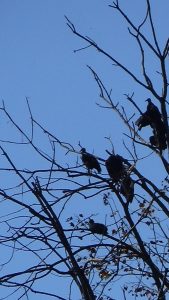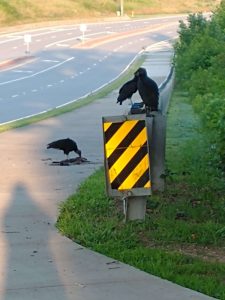Heather N. Kolich, ANR Agent, UGA Extension Forsyth County

Driving to work last Thursday, I saw a group of 4-5 black vultures picking at a furry animal carcass, about the size of a large dog, on the sidewalk of Castleberry Road. When I passed the spot that evening, there seemed to be only tufts of fur remaining. Nevertheless, three vultures were back the next morning, picking clean the spine.
Since vultures feed primarily on carrion, they provide dead animal clean-up free of charge and without sending animal carcasses to the landfill. In doing so, vultures remove disease pathogens from the environment. Their stomach acids are strong enough to allow them to digest decaying animals – including diseases the dead animal may carry, such as rabies, anthrax, and tuberculosis – without getting sick or infecting other animals.
Two species of New World vultures live year-round in Georgia: black vultures (Coragyps atratus) and turkey vultures (Cathartes aura). Populations of both may increase from October to January as birds migrate from more northerly regions for the winter. Head color is an easy identifier for vultures. Turkey vultures have bald, red heads and necks; black vultures have bald, black heads and necks. In flight, both birds soar, using thermals to gain great heights, but turkey vultures tend to wobble while black vultures are steady. Turkey vultures have a long tail and white feather ends the whole length of their wings when viewed from below. Black vultures’ tail feathers are short and stubby, and they only have white feather color at the tips of their wings. Although lighter in body, turkey vultures have a longer wingspan (5.6’-6.0’) than black vultures (5’).

Black vultures rely on sight to find their meals, but turkey vultures can sniff out hidden carrion with their keen sense of smell. Black vultures are known to soar above turkey vultures and follow them to the ground to share the feast. The black vultures repay the favor by using their strong beaks to rip open the carcass, a task that turkey vultures cannot always accomplish.
While habitat fragmentation in urban and suburban areas is detrimental to many wildlife species, human modifications such as roads, buildings, towers, and food waste create opportunities for vultures. Roads create an environment for highly visible carrion resulting from animal-vehicle collisions (roadkill) as well as thermal currents to assist in soaring flight. Roofs, communication towers, and water towers provide perches that can accommodate the communal roosting preferences of vultures.
When dozens to hundreds of vultures congregate near people, however, conflicts arise – mostly for the people. Lots of large birds create lots of excrement that can white-wash buildings, pavement, and equipment with smelly droppings. The birds can damage roofing shingles, windows, and vehicles. There’s also a creepy factor to having hordes of eaters-of-the-dead on your roof or in the yard. But consider how much mess, smell, and pestilence we’d have without these efficient wildlife service providers around.
Fun/gross vulture facts:

- To discourage encroachment, vultures vomit on animals or people that approach them.
- In hot weather, vultures poop on their legs and feet to keep them cool. The strong digestive acid released in the poop also kills bacteria transferred from their carrion meals.
- Vultures are bald because feathers would get nasty when they stick their heads into a rotting animal carcass to feed.